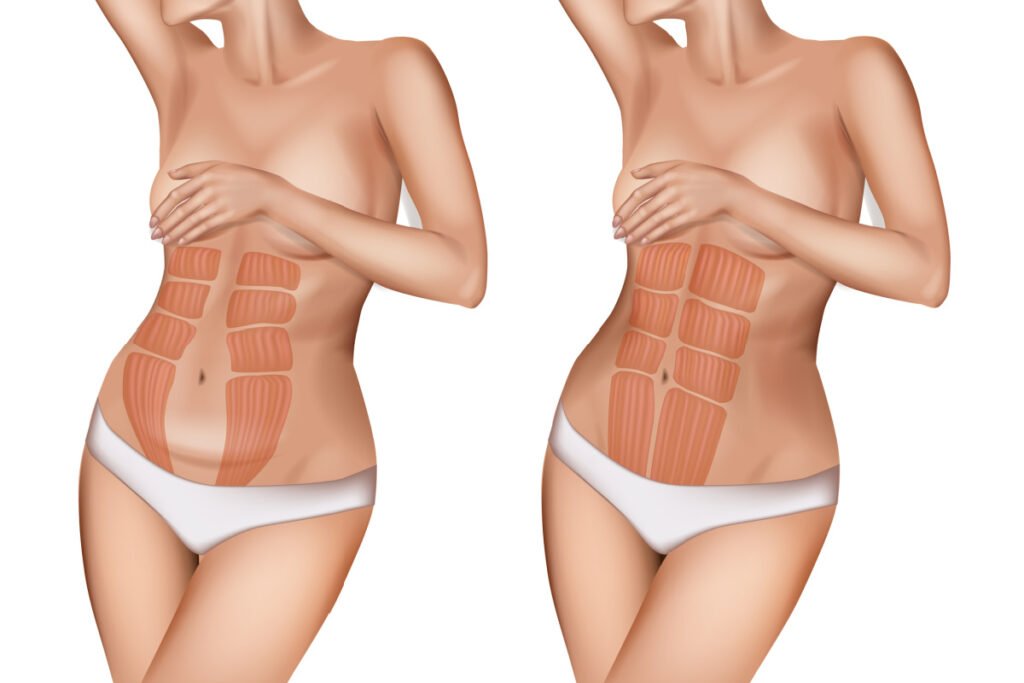A Plastic Surgeon Explains Diastasis Recti: Causes, Anatomy, and Solutions

Have you noticed a persistent bulge in your abdomen, especially post-pregnancy or after significant weight changes? This might be more than just a stubborn “tummy pooch.” It could be diastasis recti, a common and yet often undiagnosed condition.
Here, Dr. Mark Mandell-Brown and Dr. Gina Maccarone, two of the Tri-State area’s most awarded plastic surgeons, explain diastasis recti, its causes, and the effective solution we have to correct diastasis recti at our Cincinnati plastic surgery center.
What is diastasis recti?
Diastasis recti, or abdominal muscle separation, occurs when the vertical 6-pack muscles vertically separate at the body’s midline. The “six-pack” muscles (the rectus abdominis muscles) are held together at the midline by connective tissue called the linea alba. Excessive pressure, especially for long periods, over-stretches this band of tissue to the point where it cannot return to its original state.
Your abdominal muscles act as a natural “corset” to support your internal organs and tissues, and separation results in a noticeable bulge in the stomach area, often despite sit-ups and other abdominal exercises. While it isn’t always painful, the lack of structure that these core muscles provide can affect body contour and core strength.
What causes diastasis recti?
Primarily, diastasis recti is linked to pregnancy. The growing uterus stretches the abdominal muscles, which may not fully return to their original position after delivery. However, diastasis recti is not exclusive to postpartum women; rapid weight gain, improper exercise techniques, or aging can contribute to abdominal muscle separation in both men and women.
“Dr. Mandell-Brown and his staff are nothing short of phenomenal. Professional and informative every step of the way. Answered all questions day or night. I would recommend Dr Mandell Brown to anyone looking for a great plastic surgeon. I would make the 5 hour drive any time.”
—5-star Google Review
How do I know if I have diastasis recti?
A formal diagnosis requires a physical exam by a physician. We assess the state of your abdominal wall and review your medical history. Many patients with diastasis recti will also have lower back pain, mild urinary incontinence, and other symptoms caused by a lack of sufficient core support.
Diastasis recti self-assessment
In the meantime, you can perform a self-assessment at home to gauge if you may have abdominal muscle separation.
- Lie on your back with your knees bent and feet flat on the floor.
- Place your fingers above your belly button, pointing towards your toes to feel the midline of your stomach.
- Lift your head and shoulders off the ground slightly, engaging your abs.
- Feel for a gap or softness along the midline. If present, this could indicate diastasis recti.
While this self-assessment is a step in the right direction, a professional evaluation is crucial for an accurate diagnosis, determining the degree of separation, and learning your treatment options.

Correcting diastasis recti
A tummy tuck, or abdominoplasty, is the most effective solution for diastasis recti. This procedure removes precise amounts of excess skin and fat to contour your midsection for a pleasing aesthetic appearance while tightening the stretched abdominal muscles to restore their ability to support your core and help you regain functionality.
If your cosmetic concerns and abdominal muscle separation lie below the belly button only, we can perform a mini tummy tuck to tighten the lower abdominal area. However, if you have abdominal muscle separation, loose skin, and excess fat stores above and below the belly button, a standard tummy is the ideal technique.
Our expert surgeons use meticulous techniques to provide aesthetically pleasing—and functionally beneficial—results.
Is surgery the only option?
In many cases, yes; surgery is the most definitive solution, especially for significant muscle separation. If you have only a mild case of diastasis recti and do not have or are not bothered by loose skin, you may instead benefit from physical therapy with specific exercises focused on core strengthening.
About the tummy tuck surgeons at the Mandell-Brown Plastic Surgery Center
Diastasis recti, while common, does not have to be a permanent condition. If you’re seeking a professional diagnosis or considering treatment, we invite you to schedule a consultation with one of our experienced body contouring surgeons, Dr. Mark Mandell-Brown or Dr. Gina Maccarone. Call 513-984-4700 or fill out the contact form below today!
The Mandell-Brown Plastic Surgery Center is well-known in the local Cincinnati and Springboro areas, as well as nationally, for Natural Look™ cosmetic surgery results. Our award-winning surgeons have been rated the best in plastic surgery by CityBeat Magazine and the Cincinnati Enquirer for many years and are committed to helping you feel heard and supported from your consultation to your final post-op appointment.


